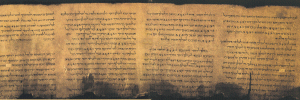That image is an extract from the Psalms Scroll in the Dead Sea Scrolls. It’s a very visual reminder of the very antiquity of the psalms, and hints at the range of situations in which people have drawn from them.
In the days when few could read, and scripture was hard to consult because it meant rolling and unrolling scrolls, people found ways of being with scripture that worked with memory rather than frequently looking things up. In setting words to music, the rich process begins when the words have been memorised and can begin to form part of the background of everything else going on throughout the day.
A very gentle way of being with psalms is to sit with the text and read through slowly and gently, getting a sense of the whole, and then savouring it more slowly, perhaps using the words as an invitation into stillness and stopping before the end, and perhaps letting them float in the back of the mind when not explicitly praying.
There’s a rich heritage of engaging with the intellect, the history and the context, but there’s also a generosity in assuming that one remembers what one needs to remember — and that God is in what does or doesn’t surface in the memory. This is a very gentle way of letting the text live and be a place of openness to God, without pretending to know the “mind of God”.
There is a generosity in being able to gently “be still … and know … that I … am God.” (Ps46:10) or letting God bring surprises through less promising verses.

